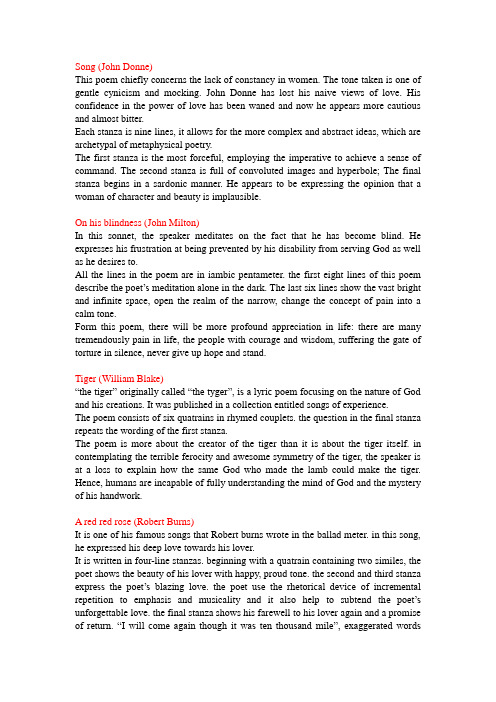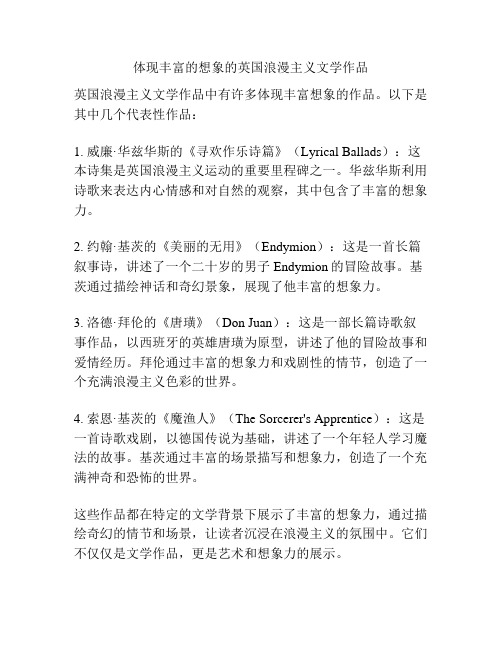英国文学作品分析
英国文学作品中生态女性主义剖析

英国文学作品中生态女性主义剖析摘要:生态女性主义来源于西方,西方女性为了独立,自由,向往美好生活,打破男权主义的压迫,在文学作品中有充分体现,例如在英国比较有代表性的作品有《简·爱》、《亚当·比德》、《呼啸山庄》,在这些文学作品中孕育人与自然的和谐,倡导男女平等,为美好的生活而努力奋斗。
本论文通过分析有代表性的英国文学作品,对其表现出来的理论思想,是以捍卫生态正义为目标,以重建人类与自然关系、在现实社会中建立男性与女性平等关系。
关键词:生态女性主义英国文学作品案例剖析在英国著名文学作品《简·爱》中女作家夏洛蒂·勃朗特通过女主人公在小说中的遭遇,表达了对当时社会的不满,对男权主义的挑战,渴望男女平等。
当简·爱面对来自不同阶层的罗切斯特的求婚时,她接受了,但是她的内心无法平静,照着镜子看穿婚纱的自己,没有看出美丽与漂亮,却没有别的新娘穿婚纱的美感,在自己面前的简直是一个陌生的自我。
里而这一种不自信反映的是夏洛特·勃朗特对于生态女性主义这一命题的不自信。
简·爱的人生结局实际上是一个孤独女性的爱情白日梦,是当时女性集体无意识的体现。
一、生态女性主义情怀在19世纪70年代出现了生态女性主义,这是经过一定时期产生的,主要表现是把生态学与政治、文化和社会运动结合在一起。
女性生态主义的宗旨是男女平等,表现与当时男性中心论作斗争,通过一些文学作品展示女性生态主义者对当时社会的不满,向往美好生活的追求。
在英国比较有代表性作品中《呼啸山庄》中凯瑟琳由于世俗社会的影响离开了呼啸山庄,但是,在她自己的内心深处还是有着对过去平静祥和的乡村生活,对希斯克里夫的爱情的深深眷恋。
而《简·爱》中的简告别了孤儿院,告别了给自己带来痛苦的城市,走入了一片寂静的乡村之中,在这个宁静的庄园之中,她实现了自己的价值,找到了自己渴望已久的爱情。
《亚当·比德》故事的展开是一片宁静的乡村,虽然亚当·比德和黛娜之间的爱情发展一波三折,但这都在黛娜的祈祷和优美的自然环境之下得以化解。
20世纪英国文学:乔治·奥威尔和艾米丽·勃朗特的作品探析

20世纪英国文学:乔治·奥威尔和艾米丽·勃朗特的作品探析引言英国文学历史悠久,20世纪是该国文学发展的重要时期。
本文将关注两位伟大的英国作家:乔治·奥威尔和艾米丽·勃朗特。
他们在20世纪均有杰出的作品,对于当代文学及社会议题产生了巨大影响力。
通过分析和探讨他们的作品,我们可以更深入地理解他们对社会、政治以及人性等主题所做出的独特贡献。
乔治·奥威尔(George Orwell)生平背景乔治·奥威尔(Eric Arthur Blair)是一位生于1903年的英国作家和记者。
他在早年经历了种种困苦和社会问题,这些经历深刻地影响了他后来的写作风格与观点。
代表作品《1984》《1984》是乔治·奥威尔最具标志性的作品之一,该小说描绘了一个极权主义统治下的未来社会。
其中包括智能监视、思想控制等主题,展现了奥威尔对于权力滥用和个人自由的忧虑。
《动物庄园》《动物庄园》是一部寓言小说,以农场上发生的斗争为背景,旨在暗喻着苏联共产主义体制下的腐败和剥削。
通过动物们反抗压迫者的故事,奥威尔揭示了权力斗争和革命运动中普遍存在的问题。
影响乔治·奥威尔以其独特的笔触和思想深度影响了后世作家及读者群体。
他对政治和社会问题敏锐的洞察力,塑造出鲜明的文学形象,并引发了对人类本性、个人自由与权力之间关系等议题的深刻思考。
艾米丽·勃朗特(Emily Brontë)生平背景艾米丽·勃朗特(Emily Brontë)是19世纪中期英国文学中最重要并备受赞誉的女作家之一。
她生于1818年,在一个有文化才华的家族中长大,并与姐姐夏洛特·勃朗特和安妮·勃朗特共同创作了众多重要的作品。
代表作品《呼啸山庄》《呼啸山庄》是艾米丽·勃朗特唯一的小说,被誉为英国文学史上最伟大的爱情小说之一。
故事讲述了两个家族之间复杂的关系、矛盾的爱情以及对人性黑暗面的深入探索。
十七世纪早期英国文学作品的特点

十七世纪早期英国文学作品的特点
英国文学在十七世纪早期发展迅速,其特点有以下几点。
首先,十七世纪早期英国文学作品的文体多样,其中最有代表性的是讽刺剧。
讽刺剧以讽刺社会现实或政治问题为主,以滑稽喜剧的方式表达观点,其中最著名的作品为约翰·温斯顿的《鲁加斯》。
此外,十七世纪早期英国文学作品还包括诗歌、小说、戏剧、传记、短篇故事和日记等文体,其中最著名的小说是乔治·拜伦的《奥林匹克的神话》。
其次,此时的英国文学作品强调人类的理性思维,特别是伊丽莎白时期的文学作品,更加强调自然科学的发展,如朱迪思·斯塔福德的《维多利亚时代的思想与宗教》和约翰·温斯顿的《莎士比亚》等人文主义作品。
此外,十七世纪早期英国文学作品还强调社会对人的影响,如约翰·温斯顿的《多样的英国》,他认为英国的不同社会群体之间有着深刻的联系,而这种联系可以帮助英国的社会继续发展。
最后,十七世纪早期的英国文学作品也更为注重宗教信仰,如乔治·拜伦的《奥林匹克的神话》,他在作品中描述了古希腊宗教对这个古老文明的影响,以及宗教信仰如何改变和影响社会。
总之,十七世纪早期英国文学作品以其多样的文体、强调人类理性
思维、重视社会对人的影响以及更加注重宗教信仰等特点,为英国文学发展做出了重要贡献,为当今文学创作提供了丰富的灵感。
英国浪漫主义文学的特征与代表作品

英国浪漫主义文学的特征与代表作品浪漫主义是一股在18世纪末至19世纪初兴起的文学和艺术运动,它对个人情感、自然界和历史传统等充满了强烈的热情和幻想。
英国浪漫主义文学在这个时期达到了巅峰,带来了一系列具有深远影响的作品,下面我们将探讨英国浪漫主义文学的特征以及代表作品。
特征一:对自然的崇拜英国浪漫主义文学的一大特征是对自然界的极度崇拜。
浪漫主义作家认为自然是对人类精神的滋养和灵感的源泉。
他们将自然界描绘成美丽、神秘和神圣的存在,强调与自然的和谐相处。
例如,威廉·华兹华斯的《抒情小诗集》中,他以优美的诗句表达了对湖泊、山景和田园风光的深深热爱。
特征二:对个体情感的追求浪漫主义文学注重个体情感的表达和追求。
作家们相信人类的内心感受比理性和客观事实更加真实和重要。
他们对个体情感的探索包括对爱情、欲望、悲伤和内心痛苦等主题的深入研究。
约翰·济慈的诗歌《秋思》中,他以细腻的语言表达了人对于逝去时光的无尽留恋和悲伤。
特征三:对历史传统的重塑浪漫主义作家对历史传统的重塑是为了反抗现存社会秩序的束缚,呼唤着人们对过去的理解和传统的重新认识。
他们通过描绘历史人物、历史事件和神话传说来重新塑造历史,并通过寓言和象征的手法,表达对于社会不公和个人自由的思考。
比如,珀西·比希·雪莱的长诗《普罗米修斯解放》中,他通过描写希腊神话中的人物普罗米修斯,表达了对专制统治和奴隶制度的批判。
特征四:对神秘和超自然的追求浪漫主义文学充满了神秘、超自然和幻想的元素,作家们探索人类灵魂深处的未知领域。
他们相信人类的灵魂与宇宙和神秘力量相通,通过对神秘与超自然的冥想和表达,传递出对人生意义和宇宙秩序的思考。
塞缪尔·泰勒·柯勒律治的《抒情诗集》中,他通过诗歌将人类的个体意识与宇宙的辽阔相融合,表达了对于人生和宇宙的深邃思考。
代表作品:1. 威廉·华兹华斯的《抒情小诗集》- 这是一部具有深远影响的诗集,描绘了自然界的美丽与神圣,以及人与自然的和谐相处。
英国文学作品分析Doc1

Song (John Donne)This poem chiefly concerns the lack of constancy in women. The tone taken is one of gentle cynicism and mocking. John Donne has lost his naive views of love. His confidence in the power of love has been waned and now he appears more cautious and almost bitter.Each stanza is nine lines, it allows for the more complex and abstract ideas, which are archetypal of metaphysical poetry.The first stanza is the most forceful, employing the imperative to achieve a sense of command. The second stanza is full of convoluted images and hyperbole; The final stanza begins in a sardonic manner. He appears to be expressing the opinion that a woman of character and beauty is implausible.On his blindness (John Milton)In this sonnet, the speaker meditates on the fact that he has become blind. He expresses his frustration at being prevented by his disability from serving God as well as he desires to.All the lines in the poem are in iambic pentameter. the first eight lines of this poem describe the poet’s meditation alone in the dark. The last six lines show the vast bright and infinite space, open the realm of the narrow, change the concept of pain into a calm tone.Form this poem, there will be more profound appreciation in life: there are many tremendously pain in life, the people with courage and wisdom, suffering the gate of torture in silence, never give up hope and stand.Tiger (William Blake)“the tiger” originally called “the tyger”, is a lyric poem focusing on the nature of God and his creations. It was published in a collection entitled songs of experience.The poem consists of six quatrains in rhymed couplets. the question in the final stanza repeats the wording of the first stanza.The poem is more about the creator of the tiger than it is about the tiger itself. in contemplating the terrible ferocity and awesome symmetry of the tiger, the speaker is at a loss to explain how the same God who made the lamb could make the tiger. Hence, humans are incapable of fully understanding the mind of God and the mystery of his handwork.A red red rose (Robert Burns)It is one of his famous songs that Robert burns wrote in the ballad meter. in this song, he expressed his deep love towards his lover.It is written in four-line stanzas. beginning with a quatrain containing two similes, the poet shows the beauty of his lover with happy, proud tone. the second and third stanza express the poet’s blazing love. the poet use the rhetorical device of incremental repetition to emphasis and musicality and it also help to subtend th e poet’s unforgettable love. the final stanza shows his farewell to his lover again and a promise of return. “I will come again though it was ten thousand mile”, exaggerated wordsconvey the poet’s infinitely affectionate feelings.I wondered lonely as a cloudThis poem was written by William Wordsworth, one of the most representative poet of the early romanticism. It consists of four six-line stanzas, in iambic tetrameter and an ABABCC rhyme scheme. At the beginning of the poem, Wordsworth compares himself to a cloud, enjoying freedom but suffering from loneliness. But the sight of a cloud of dancing daffodils makes him drunk. What's more, it brings him great courage to face depression and loneliness in the following days. Here,the daffodils is the nature. All the time,his poems concentrate on the relationship between human and nature.As William Wordsworth believed,nature can have greet healing power effect on the mind. The solitary reaperIt is written by William Wordsworth as a memorial of a tour in Scotland in 1803.This poem contains four stanzas of iambic tetrameter with a rhym e scheme of ABABCCDD in each stanza. It describes a nameless listener'sdelight in a young woman's melancholy song, as reaping grain by herself in a Scottish valley. Her song, like a found poem, springs dire ctly from nature. Her "music" runs likewater"(overflowing" the valley) and surpasses the beauty of two celebrated English song-birds, the nightingale and the cuckoo. What transfixes him in song is not its content, but its emotionally expressive music. Despite its sadness, the song helps the speaker to Mount up the hill.She Walks in Beauty (Lord Byron )She walks in beauty is universally considered as one of Byron’s most powerful works . It is an eighteen-line lyric poem. As the title says, she walks in beauty, the main theme of the poem is the description of a beautiful lady, the enumeration of certain qualities that the author considers give her beauty . What’s more, the author uses images of light and darkness interacting to describe the wide spectrum of elements in a beautiful woman's personality and looks. The three six-line stanzas of this poem all follow the same rhyme scheme and the same metrical pattern . This poem rhyme ababab , cdcdcd, efefef. And the meter of this poem is iambic tetrameter.Ode to the west windThis is one of Shelley’s best known lyrics. The poet describes vividly the activities of the west wind and then expresses his envy for the boundless freedom of it. The final line of the poem, "If the winter comes, can Spring be far behind" has often been cited to illustrate Shelley’s optimistic belief in the future of mankind.This poem is an ode on freedom and revolution. The west wind symbolizes the revolution, which is both destroyer and preserver----it can destroy the old world and create a new world. Each of the seven parts of this poem contains five stanzas—four three-line stanzas and a two-line couplet, all metered in iambic pentameter with an scheme of ABA BCB CDC DED EE.Ode on a Grecian UrnEach of the five stanzas in “Grecian Urn” is ten lines long, metered in a relatively precise iambic pentameter, and divided into a two part rhyme scheme, the last three lines of which are variable. The first seven lines of each stanza follow an ABABCDE rhyme scheme, but the second occurrences of the CDE sounds do not follow the same order.In "Ode on a Grecian Urn" Keats talks about aesthetic beauty and perfection. T he urn---art, represents beauty. Beauty is truth and so art also represents truth. The purpose of this is to exaggerate his message of timeless beauty. Keats also express sentimental feeling for the trees‘ condition, almost as if he is envious of their everlasting beauty. Tennyson: Break Break BreakThis short poem has been composed by Alfred Tennyson. In this poem the poet mourns the death of a dear friend who will never come back. It is an expression of his personal grief. But it is more than an individual cry of pain and despair. The whole lyric poem has a pleasing musical quality.In the first stanza, the poet depicts the picture of sea and its waves constantly striking against cold gray stones. In the second and third stanzas, the poet has drawn a picture of permanent and lasting images in contrast with temporariness of human life. In the l ast stanza, the poet expresses sorrow that the sweet memories of one’s life will finally become a part of the vanished past and will never come back. He will never feel the soft touch of that hand and will never hear that voice again. Shakespeare: sonnet 18Sonnet 18 is a typical English or Shakespeare sonnet. It consists of three quatrains followed by a couplet, and has the characteristic thyme scheme: abab cdcd efef gg. The major feature of this poem is analogy. It starts with a line of adoration to the beloved. The speaker then goes on to say that the beloved being described is both more lovely and more temperate than a summer’s day. The speaker lists some things that are negative about summer. It is too short and sometimes the sun shines too hot. However, the beloved being described has beauty that will last forever, unlike the fleeting beauty of a summer’s day. By putting his love’s beauty into the form of poetry, the poet is preserving it forever by the power of his written words.1. Daniel Defoe: Robinson CrusoeDaniel Defoe’s Robinson Crusoe is one of the forerunners of the English realistic novel. It creates the image of an enterprising Englishman, a typical of the English bourgeoisie of the 18th century. The whole book tells a story that the sole survivor of a shipwreck, Robinson Crusoe is isolated from civilization, he has to find ways to make a living all by himself. This novel is famous for its lovely details and its expression of belief in man’s ability when left alone in nature. And it also gl orifies labor and thebourgeois men who has the courage and will to face hardship and determination to improve his livelihood. The protagonist, Robinson is a veritable picture of the self-made, hardworking puritan, believing in diligence and the work ethic, laboring from sunrise to sundown, and resourceful and creative with a thinking mind and a skillful pair hands.2. Jonathan Swift: Gulliver’s TravelsGulliver’s travels is a novel written by the English author Jonathan Swift. It is one of the most famous literature of Satire. It tells a story of Lemuel Gulliver. When Lemuel Gulliver sets off from London on a sea voyage, little does he know the many incredible and unbelievable misadventures awaiting him. Swift uses Gulliver and his voyages primarily to examine problems with contemporary society, such as the evils of politics, humanity’s frequent foolishness, and the importance of a thoughtful, self-aware, balanced perspective. In this sense, Gulliver’s Travels addresses issues that still worry people today.3. Jane Austen: Pride and PrejudicePride and Prejudice is the one of the representative works of Jane Austen, The story follows the main character Elizabeth Bennet as she deals with issues of manners, upbringing, morality, education, and marriage. Elizabeth and Mr. Darcy first met on a ball but they were both not satisfied with each other at the first sight. However, Mr. Darcy gradually fell in love with Elizabeth but he was turned down because of his pride. At last, she was able to give up her prejudice against Mr. Darcy and realized that she was also in love with him.It is one masterpiece on the theme of love and marriage. Through the true love between Darcy and Elizabeth, Jane Austen expresses her admiration toward the love established on understanding and sincerity. Besides, she reflects the countryside people’s conservative life attitude and English women’s desire for freedom of marriage.4. Oliver TwistOliver Twist, is the second novel by English author Charles Dickens. This passage tells us the terrible conditions in the English workhouse of the time and the cruel treatment of a poor orphan by the so-called “philanthropists”. Oliver was beaten up and punished merely because he ventured to ask for an extra portion of gruel to alleviate his gnawing hungry. This is one of the details to show the extreme brutality and corruption of the oppression and their agents under the mask of philanthropy. It is in scenes like this that we see the great critical realist writer Dickens voicing the helpless suffering of the poor and the oppressed.5. Wuthering HeightsWuthering Heights is Emily Bronte’s only novel. This is a story of love and revenge. Wuthering Heights reflects the truth that in the 19th century, the people who lived in the capitalistic society were oppressed from spirit with the modality of artisticimagination. In this novel, there is not idealism and false comfort. The love between Heathcliff and Catherine is the greatest one in the world because their faithful love indomitably resists the old society which is controlled by the evil group. For avenging , he made the terrible plans and started a series of despicable actions. In the end, he go tall the wealth, however, he lost his love, his conscience and he died with sadness and hatred. Novels reflect real life has shown a strong romantic color.6. TessTess of the d'Urbervilles is a novel by Thomas Hardy. Tess struggles all her life. The whole story is filled with a feeling of dismal and doom. The tragic of Tess and her family was not that of an individual family, but was symbolic of the disintegration of the English peasantry: a progress which had reached its final and tragic stage at the end of 19th century. In this work, Hardy’s pessimistic and naturalist view of life is fully expressed: Mankind is subjected to the rule of some hostile and mysterious fate, which brings misfortune tohuman life. The novel also gives a fierce attack on the hypocritical morality of the bourgeois society and the capitalist invasion into the country and destruction.7. The Picture of Dorian GrayThe Picture of Dorian Gray is a philosophical novel by the writer Oscar Wilde. An artist who is impressed and infatuated by Dorian’s beauty; he believes that Dorian’s beauty is responsible for the new mode in his art as a painter. But Dorian soon is enthralled by the aristocrat’s hedonistic worldview. Newly understanding that his beauty will fade, Dorian expresses the desire to sell his soul, to ensure that the picture, rather than he, will age and fade. The wish is granted, and Dorian pursues a libertine life of varied and amoral experiences; all the while his portrait ages and records every soul-corrupting sin. Throughout the story, the narrative presents aestheticism as an absurd abstraction, which disillusions more than it dignifies the concept of Beauty.8.ArabyIn “Araby,”the allure of new love and distant places mingles with the familiarity of everyday drudgery, with frustrating consequences. Mangan’s sister embodies this mingling, since she is part of the familiar surroundings of the narrator’s street as well as the exotic promise of the bazaar. The tedious events that delay the narrator’s trip indicate that no room exists for love in the daily lives of Dubliners. The story presents this frustration as universal: the narrator is nameless, the girl is always Mangan’s sister as though she is any girl next door, and the story closes with the narrator imagining himself as a creature. In “Araby,” Joyce suggests that all people experience frustrated desire for love and new experiences.。
简爱的文学价值-概述说明以及解释

简爱的文学价值-概述说明以及解释1.引言1.1 概述简爱是英国作家夏洛蒂·勃朗特所著的一部小说,其中展现了主人公简·爱在逆境中追求自由与独立的成长之路。
它被广泛认为是19世纪英国文学中最重要的作品之一,因其独特的叙事风格和深入探讨人性的主题而备受赞誉。
本文旨在探讨《简爱》的文学价值,以及它对现代文学的影响和其在文学领域中的经典地位与传世价值。
在《简爱》中,勃朗特刻画了一个被命运所逼、却始终保持着内心独立和自主精神的女性形象。
故事围绕着简·爱,一个出身贫寒、孤儿般成长的女子展开。
她经历了严苛的童年,从小就被人歧视和虐待。
然而,她却并未被这些困境所打败,而是以坚韧和勇气走过了一条艰难的求学路。
勃朗特通过简·爱的经历,生动地揭示了当时妇女受到的种种限制和对女性自由的渴望,这也成为小说的核心主题之一。
该小说不仅仅是一个女性成长故事,同时也探讨了爱与自由的关系以及社会地位对个人命运的影响。
主人公简·爱与罗切斯特相爱,尽管罗切斯特已婚,但简·爱坚持追求自己的幸福与爱情。
这展示了她的独立性和对传统观念的颠覆,同时也深刻揭示了人性的复杂性和情感的深度。
勃朗特在《简爱》中精心描绘了丰富多彩的人物形象和情感世界,使读者能够深入了解每个角色的内心世界。
简·爱是一个既有强烈渴望独立自由的女性,同时又充满温柔和善良的人;罗切斯特则是一个深受伤害和痛苦折磨的男子,同时又有坚定的个性和独立精神。
通过细腻而真实的情感描写,勃朗特给予了这些角色丰富而立体的人性特征,令读者为之动容。
综上所述,夏洛蒂·勃朗特的《简爱》具有重要的文学价值。
小说通过揭示女性追求自由和独立的历程,探讨了爱情、社会地位以及个人命运等主题,引人深思。
其精心刻画的人物形象和情感描写也让读者深入感受到每个角色的内心世界。
在现代文学领域中,《简爱》所具有的文学影响力也是不可忽视的,它为后来的作品提供了重要的借鉴和启发。
英国诗歌赏析

英国诗歌赏析导言英国文学在世界文学史上占有重要地位,其诗歌作品更是为人所推崇。
从中世纪的古老诗歌传统到维多利亚时代的浪漫时期,英国诗人通过他们的作品传达了各种情感和思想。
本文将从几个重要的英国诗人入手,进行一些具体的赏析和分析。
一、威廉·莎士比亚威廉·莎士比亚(William Shakespeare)被公认为英国最伟大的文学家之一,同时也是最伟大的戏剧家之一。
在他较短的生命中,他写下了许多著名的戏剧作品,其中有许多包含着令人难忘的诗歌。
莎士比亚的诗歌展现了他独特的才华和创造力。
在他的诗歌中,我们可以看到对爱情、人性和权力等主题的深入剖析。
例如,在他的著名爱情悲剧《罗密欧与朱丽叶》中,他运用了美妙的诗句表达了两位年轻恋人之间的激情和悲伤。
其中一句“但愿这种荣耀是夏季最少的鸟儿,飞得最高的鸟儿”深深触动了无数读者的心弦。
莎士比亚的诗歌才华使他的作品经久不衰,并成为世界各地戏剧演员和诗歌爱好者的珍藏。
二、约翰·基茨约翰·基茨(John Keats)是浪漫主义时期的杰出诗人之一。
他的诗歌以其优美的形象、深情和富有感知力的文字而闻名。
基茨的诗歌表达了对自然、艺术和爱情的热情。
他的一首著名诗歌《秋夜长诗》描述了一个富有画面感的秋天夜晚。
他通过细腻的描写和富有感情的语言,让读者真切地感受到了秋天的美丽与温暖。
基茨的诗歌作品也探讨了许多深刻的主题,例如生死、时间和美的本质。
他的作品常常将寻找内心世界与对外部世界的观察和体验相结合,给人留下深刻的印象。
三、威廉·华兹华斯威廉·华兹华斯(William Wordsworth)是著名的浪漫主义诗人,也被誉为英国浪漫主义诗歌运动的领袖之一。
他的诗歌作品被誉为具有启发性和敏感性的杰作。
华兹华斯的诗歌作品主要表达了对自然和人类内心的关注。
他强调人与自然之间的亲密关系,并倡导人们回归大自然和内心的平静与安宁。
他的著名诗歌《世界太多吵闹》以诗人的视角观察现实世界,描述了城市生活的嘈杂和丛林中的宁静。
中世纪英国文学的特点和作品

中世纪英国文学的特点和作品中世纪英国文学的特点主要有以下几个方面:1. 宗教性质:中世纪英国文学具有浓厚的宗教性质,这是因为中世纪的英国社会以基督教为主导,并且教会在社会中的地位非常重要。
因此,许多中世纪英国文学作品都围绕着宗教主题展开,如《坎特伯雷故事集》中的《牧师的故事》等。
2. 骑士精神:中世纪英国文学中常常描写骑士的冒险英勇精神。
骑士被视为英雄的象征,他们追求荣誉、勇敢和忠诚。
这种骑士精神在中世纪的英国文学作品中得到了广泛的表现,如《亚瑟王传奇》中的亚瑟王和圆桌骑士们。
3. 传统民间故事:中世纪英国文学中还有许多传统的民间故事和传说。
这些故事通常以诗歌的形式出现,如《贝奥武夫》和《罗宾汉》等。
这些故事往往以传统的英雄和英雄主义为主题,反映了当时社会的价值观和道德观念。
4. 口头传统:中世纪英国文学在创作和传播上主要依靠口头传统。
在这个时期,大多数人是文盲,他们无法阅读和写作。
因此,文学作品通常是通过口头传统的方式流传下来的,例如民间故事、传说和歌谣等。
中世纪英国文学的代表作品有很多,下面我将介绍几部比较著名的作品:1. 《坎特伯雷故事集》:这是中世纪英国文学中最重要的作品之一,由乔叟创作。
故事集以一群朝圣者的旅程为背景,他们在旅途中相互讲述故事。
这些故事涵盖了各个社会阶层和不同主题,既有宗教故事,也有爱情故事和喜剧故事等。
2. 《亚瑟王传奇》:这是关于亚瑟王和他的圆桌骑士的故事。
故事中充满了冒险、魔法和英雄主义的元素,以及对骑士道德和荣誉的追求。
《亚瑟王传奇》描绘了一个理想化的中世纪英国,被视为中世纪英国文学的经典之作。
3. 《贝奥武夫》:这是一部史诗般的诗歌作品,描绘了贝奥武夫与怪物格列茅斯的斗争。
作品中充满了英雄主义、战斗和荣誉的元素,以及对勇敢和忠诚的赞美。
《贝奥武夫》被认为是中世纪英国文学的杰作之一。
4. 《罗宾汉》:这是关于罗宾汉和他的弟兄们的故事,他们在森林中与不公正的贵族和腐败的教会作斗争。
狄更斯《双城记》的小说创作风格分析

狄更斯《双城记》的小说创作风格分析一、引言在英国文学史上,查尔斯·狄更斯是一位非常具有影响力的小说家,是一位英国现实主义作家。
狄更斯出生于普通的海军小职员的家庭,他10岁时,因为家庭贫困,不得不去工厂工作,成了一名童工,他15岁后,当过一段时间的律师学徒,还从事过法庭的记录员以及录事,他20岁从事报馆采访员的工作。
1837年,狄更斯完成了《匹克威克外传》,这是他的首部长篇小说,也是他首部创作的现实主义的小说。
后来,又陆续出版了小说《雾都孤儿》《老古玩店》《双城记》《远大前程》,等等。
狄更斯善于描写生活在社会底层的小人物,他通过对小人物遭遇的描写反映当时社会的现状。
可以说,狄更斯为批判主义文学的发展做出了很大的贡献。
其中《双城记》是他的经典代表作之一,《双城记》创作于19世纪50年代,故事以法国大革命为创作背景,围绕曼马内特医生一家以及德伐日夫妇而展开,以此警醒当时的英国社会。
二、创作风格分析《双城记》是狄更斯小说创作鼎盛时期的作品,对这部小说创作风格的分析,有助于读者更好地理解这部小说。
(一)人物创作1.创作原则。
二元对立的创作手法,是小说中人物创作的基本方法之一。
《双城记》中,狄更斯采用的就是二元对立原则。
《双城记》中,每个角色因为对立而变得更加突出,每个人有着明显的人物特点,每个角色之间还具有鲜明的对比。
狄更斯利用二元对立原则,让读者通过人物角色的特质读到他想要表现的内涵,让读者通过人物角色看到故事想要表达的意义。
但二元对立的创作手法,可能会淡化多样化的人性,从而会一定程度的削弱文学中的真实感,这成为后期的一些作家在赏析狄更斯作品时会得出一些比较片面的结论。
《双城记》中,狄更斯将小说中的人物分成三类:第一类是正面的角色,第二类是反面角色,而第三类是中立角色。
通常正面角色都表现其勇敢而善良,具有同情之心和仁慈之心。
[2]反面角色则表现其凶残、可恶、贪婪、自私以及虚伪,等等,反面人物中没有正面人物的特点,而正面人物也没有反面人物的特点,作者将两个对立面的人物区分得很明确。
lawrence劳伦斯作品赏析和英国现代主义文学简介

02
劳伦斯家境贫寒,父亲是一名矿工,他的童年生活并不富裕。
劳伦斯在牛津大学学习期间曾患肺结核,这使得他与主流社会
03
产生隔阂,并对人类命运和社会现实有了更深刻的思考。
作品概述
劳伦斯的文学作品数量不多, 但涉及广泛的主题和风格。
他的早期作品以写实为主,后 期作品则逐渐表现出现代主义 的特点。
劳伦斯的作品中常常探讨的主 题包括性、社会阶级、宗教信 仰和人类命运等。
人物塑造
通过不同性格、家庭背景和社会角色的女性形象,展现了她们在 追求自由和幸福过程中的不同心态和遭遇。
03
英国现代主义文学简介
现代主义文学背景
第一次世界大战的冲击
第一次世界大战使得欧洲社会和文化的价值观受到严重动 摇,对传统社会秩序产生了深刻的影响,为现代主义文学 的产生和发展提供了社会背景。
工业革命的影响
工业革命带来了社会生产力的巨大变革,人们的生活方式 和思想观念也发生了变化,现代主义文学反映了这一时代 的特征。
科学技术的进步
20世纪初,科技取得了突破性的进展,人们对自然和人类 自身的认识发生了深刻变化,这种科技的影响也渗透到了 文学作品中。
现代主义文学特点
反传统
现代主义文学作品反对传统的文学形式和主题,强调个性、主观 性和非理性。
叙事技巧
劳伦斯在叙事技巧上运用 内心独白、意识流等现代 主义手法,展示人物的内 心世界。
象征主义
劳伦斯的作品中常使用象 征手法,通过自然元素表 达人物情感和主题思想。
对英国现代主义文学发展的贡献
推动现代主义文学的发展
劳伦斯的作品在英国现代主义文学发展史上具有重要地位,为后来的作家提供 了借鉴和启示。
人物塑造
英国文学中的幽默元素:卡夫卡和狄更斯作品的比较分析

英国文学中的幽默元素:卡夫卡和狄更斯作品的比较分析1. 引言英国文学在世界文学史上占据重要地位,其中幽默元素是其特色之一。
本文将关注两位具有代表性的作家,即弗兰茨·卡夫卡和查尔斯·狄更斯,并对他们的作品进行比较分析,探讨他们在创作中运用幽默元素的不同方式。
2. 卡夫卡与幽默2.1 卡夫卡的背景介绍弗兰茨·卡夫卡(Franz Kafka)是二十世纪最重要的捷克德语作家之一。
他以其荒诞主义风格和现实主义描写而闻名于世。
2.2 卡夫卡式幽默风格2.2.1 故事情节中的荒诞元素卡夫卡常常通过刻画荒谬的情节来传达他对社会、生活以及人类存在意义的思考。
2.2.2 对局限性和无力感的嘲讽他善于将人类在现代社会面前所经历的局限性和无力感通过幽默的方式展现,以此来批判现实世界中的不合理之处。
2.3.1 《变形记》中的幽默元素卡夫卡在《变形记》中通过将主人公格里高利·山姆塞尔变成一只巨大的甲虫,展现了人类在社会和家庭关系中所承受的愧疚感和无法逃避的责任。
2.3.2 《审判》中的幽默元素卡夫卡利用对司法制度和官僚体系进行讽刺,再加上荒诞可笑的情节构建,成功表达了对权力滥用和正义缺失的批评。
3. 狄更斯与幽默3.1 狄更斯的背景介绍查尔斯·狄更斯(Charles Dickens)是十九世纪英国最伟大的小说家之一。
他以其描写工业时代下社会阶层不平等和贫困现象而闻名于世。
3.2 狄更斯式幽默风格3.2.1 对社会问题的揭示与嘲笑狄更斯通过对社会不公正、虚伪和贫困现象的描写,运用幽默手法来嘲笑那些不道德的人和机构。
3.2.2 描写人物形象中的幽默元素他创作出许多具有鲜明个性和夸张特点的人物形象,通过幽默方式使读者产生共鸣,并一览社会中各种不同角色。
3.3.1 《双城记》中的幽默元素狄更斯在《双城记》中通过讽刺法国大革命时期法国广大农民阶层所受到的苦难,同时以夸张夺目、滑稽可笑的手法进行描写,使得阅读时兼具喜剧效果。
体现丰富的想象的英国浪漫主义文学作品

体现丰富的想象的英国浪漫主义文学作品
英国浪漫主义文学作品中有许多体现丰富想象的作品。
以下是其中几个代表性作品:
1. 威廉·华兹华斯的《寻欢作乐诗篇》(Lyrical Ballads):这本诗集是英国浪漫主义运动的重要里程碑之一。
华兹华斯利用诗歌来表达内心情感和对自然的观察,其中包含了丰富的想象力。
2. 约翰·基茨的《美丽的无用》(Endymion):这是一首长篇叙事诗,讲述了一个二十岁的男子Endymion的冒险故事。
基茨通过描绘神话和奇幻景象,展现了他丰富的想象力。
3. 洛德·拜伦的《唐璜》(Don Juan):这是一部长篇诗歌叙事作品,以西班牙的英雄唐璜为原型,讲述了他的冒险故事和爱情经历。
拜伦通过丰富的想象力和戏剧性的情节,创造了一个充满浪漫主义色彩的世界。
4. 索恩·基茨的《魔渔人》(The Sorcerer's Apprentice):这是一首诗歌戏剧,以德国传说为基础,讲述了一个年轻人学习魔法的故事。
基茨通过丰富的场景描写和想象力,创造了一个充满神奇和恐怖的世界。
这些作品都在特定的文学背景下展示了丰富的想象力,通过描绘奇幻的情节和场景,让读者沉浸在浪漫主义的氛围中。
它们不仅仅是文学作品,更是艺术和想象力的展示。
英国浪漫主义文学作品

英国浪漫主义文学作品摘要:一、英国浪漫主义文学的背景二、英国浪漫主义诗歌的特点三、英国浪漫主义小说的特点四、代表作家和作品介绍五、英国浪漫主义文学的影响正文:一、英国浪漫主义文学的背景英国浪漫主义文学起源于18世纪末,持续到19世纪30年代。
这一文学运动是对启蒙运动的反动,强调情感、自然、个性和想象力。
背景包括法国大革命、拿破仑战争以及英国工业革命等社会政治和经济变革。
二、英国浪漫主义诗歌的特点1.情感丰富:英国浪漫主义诗歌spontaneous(自发)地表达内心强烈的情感,追求真实的感受。
2.想象力丰富:创造一个充满想象的世界,远离现实主义的束缚。
3.回归自然:诗人从自然中汲取创作素材,歌颂大自然的美好。
4.同情弱者:关心社会底层,赞美平凡生活中的美好。
5.表达个性:强调个人天才,突出个性化的创作风格。
三、英国浪漫主义小说的特点1.情感真挚:浪漫主义小说充满激情,关注人物内心世界。
2.想象丰富:创造独特的虚构世界,展现丰富的想象力。
3.自然主义:小说中的人物和场景紧密联系自然,体现人与自然的和谐。
4.关注社会:揭示社会不公,关注普通人的生活和命运。
5.人物塑造:塑造鲜明的人物形象,突出个性特点。
四、代表作家和作品介绍1.威廉·华兹华斯:《抒情歌谣集》、《序曲》2.萨缪尔·泰勒·柯勒律治:《古舟子咏》、《Kubla Khan 》3.乔治·戈登·拜伦:《唐璜》、《恰尔德·哈洛德游记》4.约翰·基茨:《夜莺颂》、《希腊古瓮颂》5.简·奥斯汀:《傲慢与偏见》、《理智与情感》6.沃尔特·司各特:《艾凡赫》、《罗布·罗伊》五、英国浪漫主义文学的影响1.影响了后世文学创作,为现实主义文学奠定基础。
2.推动了文学形式的创新,如叙事诗、小说等。
3.传播了民主、自由的思想,对社会产生深远影响。
4.丰富了人类文化宝库,提供了珍贵的文学遗产。
英国浪漫主义文学作品

英国浪漫主义文学作品
(最新版)
目录
1.英国浪漫主义文学概述
2.英国浪漫主义文学的特点
3.英国浪漫主义文学的代表人物及作品
4.英国浪漫主义文学的影响和启示
正文
一、英国浪漫主义文学概述
英国浪漫主义文学是 19 世纪初期至中期英国文学的主流流派,它起源于对启蒙运动的反思和对工业革命的回应。
这一时期的文学作品强调情感、自然、历史和神秘主义,以区别于前一时期的古典主义文学。
二、英国浪漫主义文学的特点
1.强调情感:浪漫主义文学强调个人的情感和感受,把情感视为人类生活的核心。
2.热爱自然:浪漫主义文学作品中,大自然被赋予了重要的地位,成为文学创作的灵感之源。
3.历史意识:浪漫主义文学注重历史,尤其是英国历史,常常通过对历史的描绘来表达对现实社会的反思。
4.神秘主义:浪漫主义文学作品中常出现神秘、超自然的元素,以此来表现文学创作的想象力和创造力。
三、英国浪漫主义文学的代表人物及作品
1.华兹华斯:代表作品《致杜鹃》、《孤独的收割人》等。
2.约翰·济慈:代表作品《奥西曼迪亚》、《希腊古瓮颂》等。
3.乔治·戈登·拜伦:代表作品《恰尔德·哈洛尔德游记》、《唐·璜》等。
4.威廉·司各特:代表作品《艾凡赫》、《罗布·罗伊》等。
四、英国浪漫主义文学的影响和启示
英国浪漫主义文学对后世产生了深远的影响,它不仅影响了英国文学,还影响了欧洲大陆的文学。
英国文学重点作品赏析[1]
![英国文学重点作品赏析[1]](https://img.taocdn.com/s3/m/a3eae5788e9951e79b8927ad.png)
Hamlet is the first work of literature to look squarely at the stupidity, falsity and sham of everyday life, without laughing and without easy answers. In a world where things are not as they seem, Hamlet…s genuineness, thoughtfulness, and sincerity make him special.Hamlet is no saint. But unlike most of the other characters (and most people today), Hamlet chooses not to compromise with evil. Dying, Hamlet reaffirms the tragic dignity of a basically decent person in a bad worldHamlet is the first work of literature to show an ordinary person looking at the futility and wrongs in life, asking the toughest questions and coming up with honest semi-answers like most people do today.Unlike so much of popular culture today, "Hamlet" leaves us with the message that life is indeed worth living, even by imperfect people in an imperfect world.犹豫scholars have debated for centuries about Hamlet's hesitation in killing his uncle. Some see it as a plot device to prolong the action, and others see it as the result of pressure exerted by the complex philosophical and ethical issues that surround cold-blooded murder, calculated revenge and thwarted desire.More recently, psychoanalytic critics have examined Hamlet's unconscious desires (Freud concludes that Hamlet has an "Oedipal desire for his mother and the subsequent guilt [is] preventing him from murdering the man [Claudius] who has done what he unconsciously wanted to do".Analysis of “To be, or not to be”The main ideaThe speech conveys a sense of world-weariness as well as the author‟s incisive comments on the social reality of his time.Unlike the earlier single-minded avengers, Hamlet lives between action and resolution. He is so contemplative that he examines the nature of the action only to deny its possibility. He considers it better for people to die, but then says nobody knows what happens in the afterlife.One of the clearest summaries of this soliloquy was provided by Schopenhauer :'The essential purport of the world-famous monologue in Hamlet is, in condensed form, that our state is so wretched that complete non-existence would be decidedly preferable to it. Now if suicide actually offeredus this, so that the alternative "to be or not to be" lay before us in the full sense of the words, it could be chosen unconditionally as a highly desirable termination ("a consummation devoutly to be wish'd" [Act III, Sc. I.]). There is something in us, however, which tells us that this is not so, that this is not the end of things, that death is not an absolute annihilation.' .Sonnet 18This sonnet is certainly the most famous in the sequence of Shakespeare's sonnets; it may be the most famous lyric poem in English. Among Shakespeare's works, only lines such as "To be or not to be" and "Romeo, Romeo, wherefore art thou Romeo?" are better-known. This is not to say that it is at all the best or most interesting or most beautiful of the sonnets; but the simplicity and loveliness of its praise of the beloved has guaranteed its place.Meterical Patternabab cdcd efef ggThemeThe message is that in this world no beauty (in Nature) can stay except poetry or art; and your beauty can only last if I write it down in my poetry.Also notice the love play. Apparently the poet is addressing a man of his heart, the wooing sounds more like a game play than anything real and sincere. The love here is too conditional to be genuine.StructureProposal (line1-2)Argument (line3-12)Conclusion (line13-14)Sonnet 29Sonnet 29 shows us the poet at his most insecure and troubled. He feels himself unlucky, disgraced, and jealous of those around him. What is causing the poet's anguish one can only guess, but an examination of the circumstances surrounding his life at the time he wrote sonnet 29 could help us to understand his depression. In 1592, the London theatres closed due to a severe outbreak of the plague. Although it is possible that Shakespeare toured the outlying areas of London with acting companies like Pembroke's Men or Lord Strange's Men, it seems more likely that he left the theatre entirely during this time, possiblyto work on his non-dramatic poetry. The closing of the playhouses made it hard for Shakespeare and other actors of the day to earn a living. With plague and poverty threatening his life, it is only natural that he felt "in disgrace with fortune".Moreover, in 1592 there came a scathing attack on Shakespeare by dramatist Robert Greene, who wrote in a deathbed diary: "There is an upstart crow, beautified with our feathers, that with his Tygers heart wrapt in a Players hide supposes he is as well able to bombast out a blank verse as the best of you; and, being an absolute Johannes Factotum, is in his own conceit the only Shake-scene in a country." Shakespeare was deeply disturbed by this assault, feeling disgraced in "men's eyes" as well as fortune's.The poet is so forlorn that even the passion for his profession as an actor seems to have died (8). But the sonnet ends with a positive affirmation that all is not lost -- that the poet's dear friend can compensate for the grief he feels.Paradise Lost—John Milton1. IntroductionLong epic in 12 booksWritten in blank verseBased on Genesis《创世纪》in the Old TestamentDramatizes the Biblical account of humanity‟s banishment.2. Theme—Milton‟s aimed purpose: “justify the ways of God to man”(昭示天道对人的公正)—Real purpose: challenge the restored monarch·God — tyrannical, represents the king·Satan — rebelling against monarch·Love between Adam and Eve — human pursuit for happiness, the spirit of Renaissance3. Writing features—Milton style: Sonority洪亮, Eloquence雄辩, Majesty尊严, Grandeur壮美·The blank verse·Long and involved sentences—Latinate style·Inversion·AllusionWilliam BlakeThe LameThe poem is written in rhyming couplets with alternating iambic and anapestic feet. it‟s one of the poems that collected in Songs of Innocence which express the poe t‟s delight in life, even in the face of sorrow and suffering.The poem is a child song, in the form of a question and answer. The first stanza is rural and descriptive, while the second focuses on abstract spiritual matters and contains explanation and analogy. The child‟s question is both na?ve and profound. “who made thee” is a simple question, but the child is also tapping into the deep and timeless questions that all human beings have, about their own origins and the nature of creation. The situation of a child talking to an animal is a believable one. Yet by answering his own question the child coverts it into a rhetorical one, thus counteraction the initial spontaneous sense of the poem, and also reveals his confidence in his simple Christian faith and his innocent acceptance of its teachings.The lamb symbolizes Jesus, as Jesus has a traditional image as a lamb. The image of the child is also associated with Jesus: in the Gospel, Jesus displays a special concern for children. This poem, like many of the poems in Songs of Innocence, accepts that Blake saw as the most positive aspects of conventional Christian belief.Robinson Crusoe—Daniel Defoe1. Theme:—to sing the praises of human labor—to celebrate the strength of human rational will to conquer the natural environment—to beautify colonialism & Negro slavery2. Plot:run away from home → become a sailor → a planter in Brazil → to an uninhabited island because of shipwreck → made a living there all by himself → save a negro named Friday who became his servant → back to England → visit the remote island again and Friday was killed3. Robinson Crusoe’s characterization:typical of the rising English bourgeois class, practical, diligent, a restless curiosity to know more about the world and a desire to prove individual power in the face of social and natural challenges; shrewd, care about money and good at managing; courageous and intelligent to overcome all kinds of obstacles4. Style:journalistic truth with many vivid details, simple and plain sentence structure and language, first person point of view, natural order in narration, making the story intimate to the readers and become popular among lower classesRobinson is a grand hero in westerners‟ eyes. He survived in the deserted island and led a meaningful life.Robinson is a colonist, as can be seen from his selling the boy who helped save his life at the beginning of the novel.Robinson is a capitalist, as can be seen from his disposal of the gold coins he happens to find on the wrecked ship.Robinson is a man chauvinist, as can be seen from his comment on women.Robinson Crusoe is the first important English novel in the picaresque tradition. It is also the fundamental work in English island literature.Robert BurnsA Red, Red, RoseThe metrical pattern of the poem is basically in the ballad form, i.e. each stanza consisting of four lines, with four stressed syllables in the odd-numbered lines and three stressed syllables in theeven-numbered lines, and with rhymes occurring on the even-numbered lines.The image of rose evokes traditional associations of beauty, love and romance. Its simple lyrics and straight form and expression of feeling make it a favorite choice for poetry anthologies and a most appreciated poem for readers. Incorporating various elements from folk songs, the poem is supposed to be a song sung by an Irish sailor to his sweet heart before his ship sailed off to sea, the exaggerated declaration of love “till the seas are gone dry and till the rock melts” can remind us of a well known Chinese oath. There is no tearful parting. But determined hope of reunion: the sailor will come back to his sweet heart” though it were ten thousand miles.”。
英国文学史诗歌分析

1. Sonnet 18----William Shakespeare Shall I compare thee to a summer's day?(Could I compare you to the time of summer?)Thou art more lovely and more temperate:(You are more lovely and more gentle and mild than the days)(Rough winds do shake the darling buds of May,(The wild winds shakes the favorite flowers of May. )And summer's lease hath all too short a date:(And the duration of summer has a limited period of time)Sometime too hot the eye of heaven shines,(Sometimes the sun shining is too hot. )And often is his gold complexion dimmed;(Or often goes behind the clouds.)And every fair from fair sometime declines,(And everything beautiful will lose its beauty.)By chance or nature's changing course untrimmed;(By misfortune or by nature’s planned out course)But thy eternal summer shall not fade ,(But your youth shall not fade)Nor lose possession of that fair thou ow’st;(Nor will you lose the beauty that you possessed)Nor shall Death brag thou wander'rest in his shade,(Nor will death claim you for his own)When in eternal lines to time thou grow’st(Because in my eternal verse you will live forever)So long as men can breathe or eyes can see,(So long as the men can live in the world with sight and breath)So long lives this, and this gives life to thee.(This poem will exist and you will live in forever.)a)The author of the poem is William Shakespeare .It is a typical English sonnet, the rhymescheme of the poem is “abab cdcd efef gg”.b)On the surface the poem is simply a statement to praise the beauty of the young man. But themore important is the poet wants to show the power of the poem which can defy time and last forever. The stability of love and its power to immortalize the subject of the poet's verse is the theme.2. On His Blindness----John MiltonWhen I consider how my light is spent 想到了在这茫茫黑暗的世界里Ere half my days, in this dark world and wide还未到半生这两眼就已失明,And that one talent which is death to hide ,想到了我的才能,要是埋起来,Lodged with me useless, though my soul more bent 会招致死亡,却放在我手里无用,To serve therewith my Maker, and present 虽然我一心想用它服务造物主,My true account, lest He, returning chide;免得报账时,得不到他的宽容;"Doth God exact day-labor, light denied?" "神不给我光明,还让我做日工 ?’’想到这,I fondly ask. But Patience, to prevent 我愚蠢地自问.但"忍耐"看我在抱怨,That murmur, soon replies, "God doth not need" 立刻止住我,神并不要你工作,Either man's work or his own gifts.;Who best 或还他礼物。
苔丝的悲剧及其现实意义分析文献综述

苔丝的悲剧及其现实意义分析文献综述苔丝的悲剧是英国著名的文学作品,由莎士比亚所著的莎士比亚悲剧
的代表作,是英国文学史上最令人记忆深刻的悲剧之一、据史料记载,它
是英国著名的女性诗人苔丝·洛伊的作品,于1594年首次上演,由苔丝·洛伊亲自扮演女主角苔丝,而在英国的文学史上留下了深远的影响。
在当今的英国文学中,《苔丝》仍然被写进大学文学课程中,一直吸引着
新的读者认识它。
苔丝的悲剧本身充满了悲剧气氛和哀怨情绪,描绘了苔丝在偏见社会
上挣扎的情况,这也是它的现实意义所在。
主要表现了它在社会上受到的
歧视和歧视的后果,以及它在激烈的社会竞争中被冷落、被忽视的经历。
苔丝就是一个被社会遗忘的英雄,她的遭遇也可以当作一种警示,提醒人
们不要被歧视,尊重和尊重每一个个体的价值。
它还丰富了英国文学的主题,体现了当时社会的现实现象:通过反映女性及其家庭遭受的社会歧视,提出性别歧视的危害,启发人们去倡导和弘扬平等的价值观。
综上所述,苔丝的悲剧及其现实意义已经引起了学术界的广泛关注。
经过调研分析,有一些学者就苔丝的悲剧及其现实意义进行了深入的研究
和评价。
- 1、下载文档前请自行甄别文档内容的完整性,平台不提供额外的编辑、内容补充、找答案等附加服务。
- 2、"仅部分预览"的文档,不可在线预览部分如存在完整性等问题,可反馈申请退款(可完整预览的文档不适用该条件!)。
- 3、如文档侵犯您的权益,请联系客服反馈,我们会尽快为您处理(人工客服工作时间:9:00-18:30)。
Wordsworth was a defining member of the English Romantic Movement.华兹华斯是英国浪漫主义诗歌的代表人物之一。
Like other Romantics, Wordsworth’s personality and poetry were deeply influenced by his love of nature, especially by the sights and scenes of the Lake Country, in which he spent most of his mature life.对自然的热爱以及他大部分人生所度过的地方--湖区--的风光景色都对他的性格和作品有着深远的影响。
A profoundly earnest and sincere thinker, he displayed a high seriousness tempered with tenderness and a love of simplicity.他是一位真挚深刻的思想者,作品在严谨中充满纯真质朴与敏感。
I Wandered Lonely as a Cloud我孤独地漫游,像一朵云William WordsworthI wandered lonely as a cloud我孤独地漫游,像一朵云That floats on high o´er vales and hills,在山丘和谷地上飘荡,When all at once I saw a crowd,忽然间我看见一群A host, of golden daffodils;金色的水仙花迎春开放,Beside the lake, beneath the trees,在树荫下,在湖水边,Fluttering and dancing in the breeze.迎着微风起舞翩翩。
Continuous as the stars that shine连绵不绝,如繁星灿烂,And twinkle on the milky way,在银河里闪闪发光,They stretched in never-ending line它们沿着湖湾的边缘Along the margin of a bay:延伸成无穷无尽的一行;Ten thousand saw I at a glance,我一眼看见了一万朵,Tossing their heads in sprightly dance.在欢舞之中起伏颠簸。
The waves beside them danced;but they 粼粼波光也在跳着舞,Out-did the sparkling waves in glee:水仙的欢欣却胜过水波;A poet could not but be gay,与这样快活的伴侣为伍,In such a jocund company:诗人怎能不满心欢乐!I gazed--and gazed--but little thought我久久凝望,却想象不到What wealth the show to me had brought: 这奇景赋予我多少财宝,——For oft, when on my couch I lie每当我躺在床上不眠,In vacant or in pensive mood,或心神空茫,或默默沉思,They flash upon that inward eye它们常在心灵中闪现,Which is the bliss of solitude;那是孤独之中的福祉;And then my heart with pleasure fills,于是我的心便涨满幸福,And dances with the daffodils.和水仙一同翩翩起舞。
SummaryThe speaker says that, wandering like a cloud floating above hills and valleys, he encountered a field of daffodils beside a lake. The dancing, fluttering flowers stretched endlessly along the shore, and though the waves of the lake danced beside the flowers, the daffodils outdid the water in glee. The speaker says that a poet could not help but be happy in such a joyful company of flowers. He says that he stared and stared, but did not realize what wealth the scene would bring him. For now, whenever he feels “vacant” or “pensive,” the memory flashes upon “that inward eye / That is the bliss of solitude,” and his heart fills with pleasure, “and dances with the daffodils.”FormThe four six-line stanzas of this poem follow a quatrain-couplet rhyme scheme: ABABCC. Each line is metered in iambic tetrameter.CommentaryThis simple poem, one of the loveliest and most famous in the Wordsworth canon, revisits the familiar subjects of nature and memory, this time with a particularly (simple) spare, musical eloquence. The plot is extremely simple, depicting the poet’s wandering and his discovery of a field of daffodils by a lake, the memory of which pleases him and comforts him when he is lonely, bored, or restless. The characterization of the sudden occurrence of a memory—the daffodils “flash upon the inward eye / Which is the bliss of solitude”—is psychologically acute, but the poem’s main brilliance lies in the reverse personification of its early stanzas. The speaker is metaphorically compared to a natural object, a cloud—“I wandered lonely as a cloud / That floats on high...”, and the daffodils are continually personified as human beings, dancing and “tossing their heads” in “a crowd, a host.” This technique implies an inherent unity between man and nature, making it one of Wordsworth’s most basic and effective methods for instilling in the reader the feeling the poet so often describes himself as experiencing.My last duchess我已故的公爵夫人Type of Work: "My Last Duchess" is a dramatic monologue, a poem with a character who presents an account centering on a particular topic. This character speaks all the words in the poem. During his discourse, the speaker intentionally or unintentionally reveals information about one or more of the following: his personality, his state of mind, his attitude toward his topic, and his response or reaction to developments relating to his topic . The main focus of a dramatic monologue is this personal information, not the topic which the speaker happens to be discussing. The word monologue is derived from a Greek word meaning to speak alone.The Portrait of the Duchess: The portrait of the late Duchess of Ferrara is a fresco, a type of work painted in watercolors directly on a plaster wall. The portrait symbolizes the duke's possessive and controlling nature inasmuch as the duchess has become an art object which he owns and controls.Meter: "My Last Duchess" is in iambic pentameter, which has ten syllables, or five feet, per line. The ten syllables consist of five pairs of unstressed and stressed syllables. Lines 1 and 2 of the poem demonstrate the iambic-pentameter pattern..Rhyme: Heroic CoupletsLine 1 rhymes with line 2, line 3 with 4, line 5 with 6, and so on. Pairs of rhyming lines are called couplets. When the lines are written in iambic pentameter, as are the lines of "My Last Duchess," the rhyming pairs are called heroic couplets.Meter......."My Last Duchess" is in iambic pentameter, which has ten syllables, or five feet, per line. The ten syllables consist of five pairs of unstressed and stressed syllables. Lines 1 and 2 of the poem demonstrate the iambic-pentameter pattern..Rhyme: Heroic Couplets.......Line 1 rhymes with line 2, line 3 with 4, line 5 with 6, and so on. Pairs of rhyming lines are called couplets. When the lines are written in iambic pentameter, as are the lines of "My Last Duchess," the rhyming pairs are called heroic couplets.Themes :Arrogance:.The theme is the arrogant, authoritarian mindset of a proud Renaissance duke, who says, "I choose / Never to stoop" (lines 42-43). In this respect, the more important portrait in the poem is the one the duke "paints" of himself with his words.Women as Mere Objects: Several lines in the poem suggest that the duke had treated his wife as a mere object. He expected her to be beautiful to look at, but little more. But the duchess was human; she had faults. When the duke became annoyed by them and by her smiling face, he "gave commands" that ended her smiling. In other words, he apparently ordered her to be killed. The word last in the title suggests that the young woman in the portrait was not the duke's first wife. One wonders whether his previous wife (or wives) met the same fate and whether his next duchess will end up like his "last duchess."。
